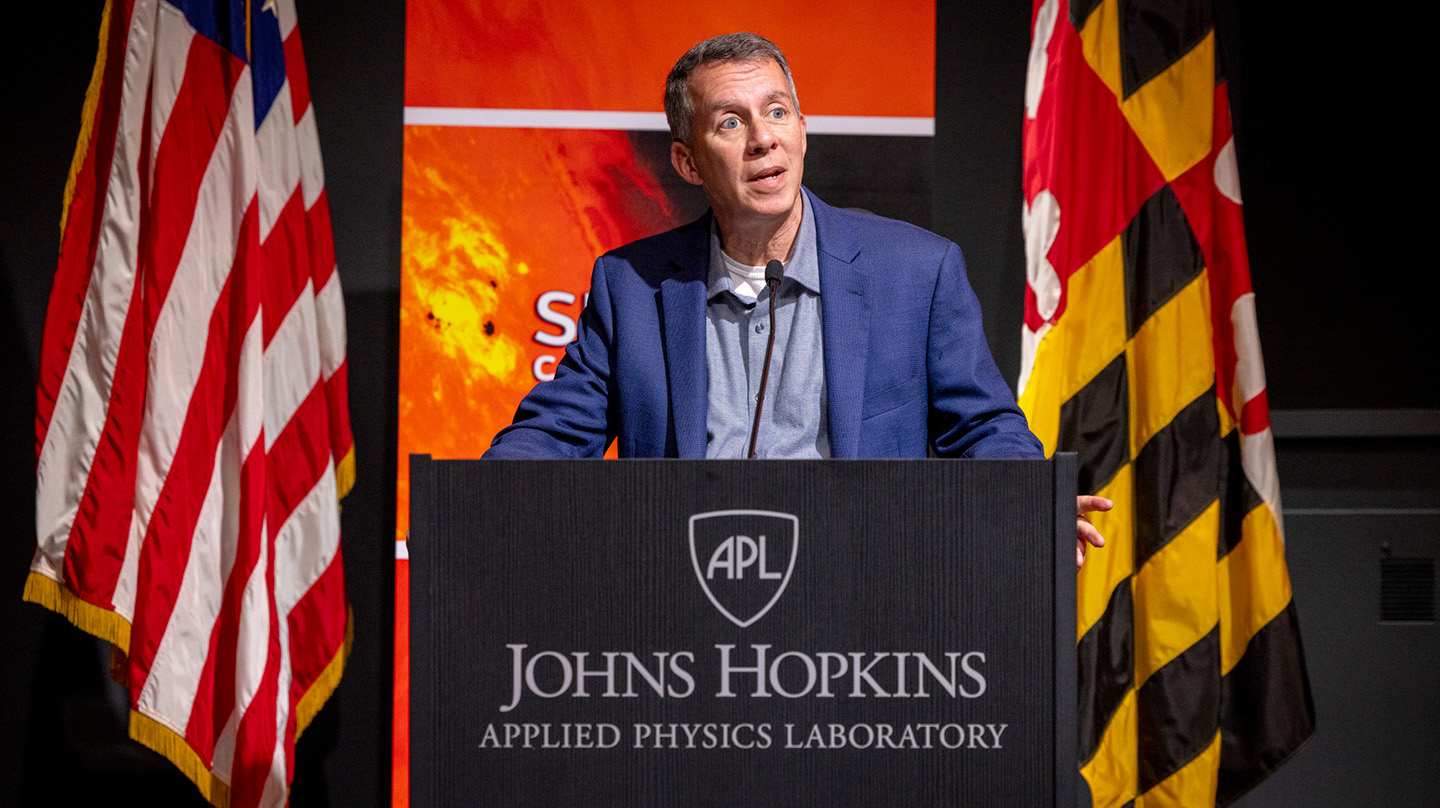Press Release
Johns Hopkins APL Conference Explores Preparedness for Next Space Weather Event
With the Sun approaching its next peak in solar activity, space weather experts convened at the Johns Hopkins Applied Physics Laboratory (APL) in Laurel, Maryland, to discuss how top agencies are preparing for a potential impact on national security.
APL hosted the Space Environment Applications Systems and Operations for National Security (SEASONS) 2023 Conference in November, welcoming representatives from the White House, NASA, the National Oceanic and Atmospheric Administration (NOAA), the Department of Defense (DoD) and other top institutions to explore how to best predict the impact of the latest solar cycle on Earth.
Since 2008, the SEASONS conference has served as a forum for experts to discuss the potential impacts space weather might have on national security both today and in the future. This year’s conference included keynote speakers from the White House and United States Air Force.
The NOAA Space Weather Prediction Center’s recently revised forecast concluded that solar activity during its next peak — called the solar maximum — will increase more quickly and reach a higher peak than previously predicted. The current solar cycle is expected to peak between January and October 2024.
Space weather encompasses events generated by solar activity, and can produce dazzling phenomena such as the aurora borealis and australis, or northern and southern lights, respectively.
It can also spark events capable of more significant impacts on Earth, such as knocking out power grids or disrupting satellites. Experts predict a severe solar storm could lead to trillions of dollars in damage.
“Space weather predictions and impacts cut across the civil and national security space domains and are important to all of us,” said Bobby Braun, head of APL’s Space Exploration Sector (SES), to kick off the SEASONS conference on Nov. 7. “This is why we need to plan, discuss and prepare as best we can to help facilitate the growth of this community.”
The Value of Space Weather Data
Representatives from APL, NASA, the White House and other organizations outlined steps they have taken to bolster U.S. expertise in space weather research and prediction.
Dr. Ezinne Uzo-Okoro, assistant director for space policy in the White House’s Office of Science and Technology Policy, said during her keynote address that several objectives have been achieved to advance space weather forecasting through improved observations and modeling capabilities.
“We as a nation will continue to build capabilities to improve the safety and security of our critical infrastructure and ensure that the United States remains a global leader in space weather observations, space weather research and space weather forecasting,” Uzo-Okoro said.
In his keynote, Col. Patrick Williams, the Air Force’s director of weather, and deputy chief of staff for operations, focused on space weather priorities and opportunities. His presentation on the second day set the stage for the rest of the conference that focused on space weather impacts on DoD acquisitions, research and operations.
The SEASONS conference also featured a panel discussion on the commercial space industry’s readiness for the next solar maximum, with experts including Sarah Vines, a space physics researcher at APL and principal investigator for the Active Magnetosphere and Planetary Electrodynamics Response Experiment (AMPERE).
The AMPERE program employs commercial low-Earth-orbiting satellites that collect nearly continuous measurements of electrical currents flowing in Earth’s upper atmosphere. These currents are coupled to the magnetosphere, where Earth’s magnetic field resides. AMPERE tracks when these currents shift or intensify, and could play a key role in predicting how our planet is affected by space weather.
“What can we do with this data at this intersection of DoD, of industry, of science to help all these different communities prepare for space weather impacts?” asked Vines during the panel.
The conference also touched on tools and models available or in development that could further advance prediction capabilities, such as the Peri-Geospace Observing Network concept, an architecture conceived by APL heliophysicist Angelos Vourlidas. The satellite constellation would measure the solar wind at the first LaGrange point, or L1, just upstream of Earth’s magnetosphere to provide more accurate predictions of the impact of a space weather event.
“The incoming structure of the solar wind can change even in that short distance, the ‘last mile,’ so to speak,” said Vourlidas. “It’s this evolution that throws off a lot of the more precise forecasting required by some users.”
A Deep History Studying Space Weather
APL manages multiple missions and projects to further understanding and predicting the effects of space weather. For example, Parker Solar Probe, launched in 2018, continues to provide new data on solar activity. In September 2022, it was the first spacecraft ever to fly through a coronal mass ejection — a powerful solar explosion — so close to the Sun.
The Laboratory also leads the Center for Geospace Storms, comprising space weather experts from around the U.S., to develop a state-of-the-art model of geospace — a region of space around Earth that includes the upper atmosphere — to help improve our understanding of space weather events. The project is part of NASA’s Diversify, Realize, Integrate, Venture, Educate (DRIVE) Science Centers program.
Next May, APL will host a space weather tabletop exercise sponsored by NASA, NOAA and the National Science Foundation to prepare for a hypothetical significant space weather event. Dipak Srinivasan, the tabletop exercise program manager at APL, said the endeavor will help government leaders and space weather experts uncover and fill any potential gaps in assessment of and response to a space weather event.
“We have to make sure that our communication pathways are working — that we’re distilling information properly and that it’s clearly understood — so people can take action,” Srinivasan said during the conference. “Because the time between our detection of an incoming event and the time when we have to start performing mitigating operations is very short.”
